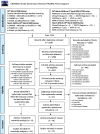Systematic review of outcome domains and instruments used in designs of clinical trials for interventions that seek to restore bilateral and binaural hearing in adults with unilateral severe to profound sensorineural hearing loss ('single-sided deafness')
- PMID: 33743802
- PMCID: PMC7981927
- DOI: 10.1186/s13063-021-05160-5
Systematic review of outcome domains and instruments used in designs of clinical trials for interventions that seek to restore bilateral and binaural hearing in adults with unilateral severe to profound sensorineural hearing loss ('single-sided deafness')
Abstract
Background: This systematic review aimed to identify, compare and contrast outcome domains and outcome instruments reported in studies investigating interventions that seek to restore bilateral (two-sided) and/or binaural (both ears) hearing in adults with single-sided deafness (SSD). Findings can inform the development of evidence-based guidance to facilitate design decisions for confirmatory trials.
Methods: Records were identified by searching MEDLINE, EMBASE, PubMed, CINAHL, ClinicalTrials.gov, ISRCTN, CENTRAL, WHO ICTRP and the NIHR UK clinical trials gateway. The search included records published from 1946 to March 2020. Included studies were those as follows: (a) recruiting adults aged 18 years or older diagnosed with SSD of average threshold severity worse than 70 dB HL in the worse-hearing ear and normal (or near-normal) hearing in the better-hearing ear, (b) evaluating interventions to restore bilateral and/or binaural hearing and (c) enrolling those adults in a controlled trial, before-and-after study or cross-over study. Studies that fell just short of the participant eligibility criteria were included in a separate sensitivity analysis.
Results: Ninety-six studies were included (72 full inclusion, 24 sensitivity analysis). For fully included studies, 37 exclusively evaluated interventions to re-establish bilateral hearing and 29 exclusively evaluated interventions to restore binaural hearing. Overall, 520 outcome domains were identified (350 primary and 170 secondary). Speech-related outcome domains were the most common (74% of studies), followed by spatial-related domains (60% of studies). A total of 344 unique outcome instruments were reported. Speech-related outcome domains were measured by 73 different instruments and spatial-related domains by 43 different instruments. There was considerable variability in duration of follow-up, ranging from acute (baseline) testing to 10 years after the intervention. The sensitivity analysis identified no additional outcome domains.
Conclusions: This review identified large variability in the reporting of outcome domains and instruments in studies evaluating the therapeutic benefits and harms of SSD interventions. Reports frequently omitted information on what domains the study intended to assess, and on what instruments were used to measure which domains.
Trial registration: The systematic review protocol is registered on PROSPERO (International Prospective Register of Systematic Reviews): Registration Number CRD42018084274 . Registered on 13 March 2018, last revised on 7th of May 2019.
Keywords: Clinical trial design; Hearing interventions; Measurement instruments; Outcome domains; Single-sided deafness.
Conflict of interest statement
PTK declared research grants and support in kind awarded to his institution for research projects in the field of SSD from manufacturers of hearing devices. All other authors declare that they have no competing interests.
Figures


Similar articles
-
Hearing Instruments for Unilateral Severe-to-Profound Sensorineural Hearing Loss in Adults: A Systematic Review and Meta-Analysis.Ear Hear. 2016 Sep-Oct;37(5):495-507. doi: 10.1097/AUD.0000000000000313. Ear Hear. 2016. PMID: 27232073 Free PMC article.
-
Ear drops for the removal of ear wax.Cochrane Database Syst Rev. 2018 Jul 25;7(7):CD012171. doi: 10.1002/14651858.CD012171.pub2. Cochrane Database Syst Rev. 2018. PMID: 30043448 Free PMC article.
-
Eliciting adverse effects data from participants in clinical trials.Cochrane Database Syst Rev. 2018 Jan 16;1(1):MR000039. doi: 10.1002/14651858.MR000039.pub2. Cochrane Database Syst Rev. 2018. PMID: 29372930 Free PMC article.
-
Systematic review of outcome domains and instruments used in clinical trials of tinnitus treatments in adults.Trials. 2016 Jun 1;17(1):270. doi: 10.1186/s13063-016-1399-9. Trials. 2016. PMID: 27250987 Free PMC article.
-
Grommets (ventilation tubes) for hearing loss associated with otitis media with effusion in children.Cochrane Database Syst Rev. 2005 Jan 25;(1):CD001801. doi: 10.1002/14651858.CD001801.pub2. Cochrane Database Syst Rev. 2005. Update in: Cochrane Database Syst Rev. 2010 Oct 06;(10):CD001801. doi: 10.1002/14651858.CD001801.pub3. PMID: 15674886 Updated.
Cited by
-
The Assessments of Music Therapy for Dementia Based on the Cochrane Review.Dement Geriatr Cogn Dis Extra. 2022 Jan 21;12(1):6-13. doi: 10.1159/000521231. eCollection 2022 Jan-Apr. Dement Geriatr Cogn Dis Extra. 2022. PMID: 35222502 Free PMC article. Review.
-
Core Rehabilitation Outcome Set for Single Sided Deafness (CROSSSD) study: protocol for an international consensus on outcome measures for single sided deafness interventions using a modified Delphi survey.Trials. 2020 Mar 4;21(1):238. doi: 10.1186/s13063-020-4094-9. Trials. 2020. PMID: 32131880 Free PMC article.
-
Swallowing outcomes in dysphagia interventions in Parkinson's disease: a scoping review.BMJ Evid Based Med. 2023 Apr;28(2):111-118. doi: 10.1136/bmjebm-2022-112082. Epub 2022 Nov 11. BMJ Evid Based Med. 2023. PMID: 36368883 Free PMC article.
-
Linking Affective and Hearing Sciences-Affective Audiology.Trends Hear. 2023 Jan-Dec;27:23312165231208377. doi: 10.1177/23312165231208377. Trends Hear. 2023. PMID: 37904515 Free PMC article. Review.
-
Impact of dexmedetomidine on agitation and inflammatory response during recovery from anesthesia in young children following cochlear implantation surgery.BMC Anesthesiol. 2025 Feb 25;25(1):102. doi: 10.1186/s12871-025-02970-x. BMC Anesthesiol. 2025. PMID: 40000934 Free PMC article. Clinical Trial.
References
-
- Van de Heyning P, Távora-Vieira D, Mertens G, Van Rompaey V, Rajan GP, Müller J, Hempel JM, Leander D, Polterauer D, Marx M, Usami SI, Kitoh R, Miyagawa M, Moteki H, Smilsky K, Baumgartner WD, Keintzel TG, Sprinzl GM, Wolf-Magele A, et al. Towards a unified testing framework for single-sided deafness studies: A consensus paper. Audiol Neurootol. 2017;21:391–398. doi: 10.1159/000455058. - DOI - PMC - PubMed
-
- Widen JE, Folsom RC, Cone-Wesson B, Carty L, Dunnell JJ, Koebsell K, Levi A, Mancl L, Ohlrich B, Trouba S, Gorga MP, Sininger YS, Vohr BR, Norton SJ. Identification of neonatal hearing impairment: hearing status at 8 to 12 months corrected age using a visual reinforcement audiometry protocol. Ear Hear. 2000;21:471–487. doi: 10.1097/00003446-200010000-00011. - DOI - PubMed
Publication types
MeSH terms
Grants and funding
LinkOut - more resources
Full Text Sources
Other Literature Sources
Medical
Miscellaneous

